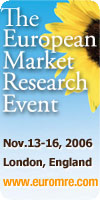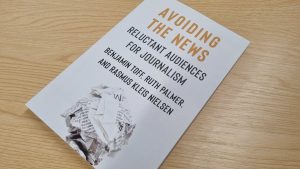European Market Research Event – Day 1, morning
My selection of talks is purely based on personal preferences and obviously only a snapshot of about a third of the event.
I have the conference CD’s with most of the presentation files and have uploaded some of those that I attended on this blog (with approval of the authors involved). If you are interested in the presentation files of one of the other talks, just let me know.
Flemming Ostergaard, LEGO
I started off the day with Flemming Ostergaard, Marketing Innovation Director at Lego, whose talk “Leveraging Ethnography and Anthropological Research to Innovate” describes how LEGO works on understanding kids and kids play and how to translate these insights into new products and play innovation.
LEGO as a company is facing some major challenges, e.g. the huge pressure from tech toys, the fact that kids are getting older younger, and the shortened production cycle, that have made innovation crucial for the company.
To innovate they need a much sharper understanding of the needs of kids. To achieve this, LEGO uses a variety of user research techniques, including:
- Be the Kid – participatory observation where adults became kids;
- Know the Shopper – observation & desk research, particularly looking at the interaction between children and parents and at how children shop;
- Find the Forces – context and trends research;
- Find the Fun – ethnographic research (15 days of hanging out with kids);
- Map the Industry – innovation diagnostics with a focus of trying to understand the ingredients of successful innovation;
- Find the Stories – context research through talking to authors and scriptwriters.
This research brought about an insight into some of the core values that are crucial now, such as complexity, new playing fields and the need for privacy.
LEGO uses a six pillar approach to turn these values into patterns and “innovation vectors”, and looked for instance at a privacy-inspired solution, called “Mutants by Mail” that covers all the needs of the parents, but also of the child, through a clever use of the mobile phone.
In addition to straightforward user research, LEGO also builds on the power of user communities, through its use of ‘Adult Fans Of Lego’ (the so-called AFOL’s) in the development of the second version of MindStorm, and in user co-creation, through its already well-known LEGO Factory.
A big issue is still the ‘creative leap’: how to take the insights that were gained from understanding and make these into relevant new products concepts. Ostergaard had to admit that the company is are not fully there yet. But one of the ways to make sure user research and creativity are well integrated is by involving creative people part of the full research process, not just the design process.
Tony Linford, Hi-Tec Sports
Tony Linford, the marketing director of Hi-Tec Sports, took a much more intuitive and much less formalised approach to user understanding.
Hi-Tec is an English manufacturer of sports footwear, founded in the 70’s by Dutch entrepreneur Frank Van Wezel.
The key to innovation, according to Linford, is a mixture of being very close to the end users, emotional and intuitive understanding of their needs, a highly scientific, problem-solving approach which leads to a series of steadily improving prototypes, and simple entrepreneurial guts to go for something that you think makes sense.
Hi-Tec works a lot with individual lead users, such as professional golfer Padraig Harrington, for whom they developed a set of new high-performance golf shoes.
The company’s latest concept is 4:SYS (pronounced “Forces”). It analyses the different forces applied by the barefoot during the running gait and came up with a sole that mimicked and helps this natural pressure.
Download presentation (pdf, 264 kb, 20 slides)
Anat Amir, O2
Anat Amir, who is the head of product experience and research at O2, a UK telecom provider, gave the last talk I attended in the morning.
Amir was one of the people in charge of a 6 month pilot study or user trial with 375 participants in Oxford, UK of Digital Video Broadcast (DVB-H), which is multi-channel TV broadcast directly to mobiles.
Although the pilot study had mostly a technical aim, and the results were quite positive, Amir hinted at a number of usability, context of use and user experience issues that I would have loved to hear more about, but that were difficult to discuss at this stage because of NDA.
More information about the project can be found on the Arqiva website.





[…] (I was also there and covered the event on this blog (here, here and here). In June I plan to do the same in Barcelona.) […]
[…] Flemming Ostergaard (Lego) ha parlato dell’importanza della ricerca antropologica ed etnografica per lo sviluppo di nuovi prodotti. Il coinvolgimento dei clienti nel design è fondamentale. […]